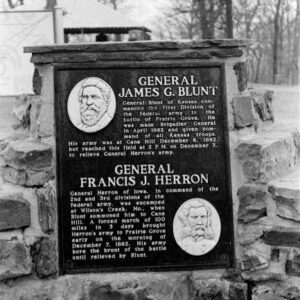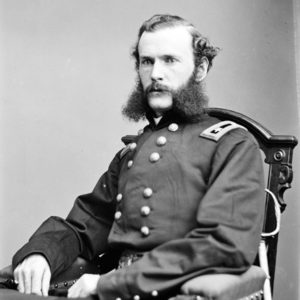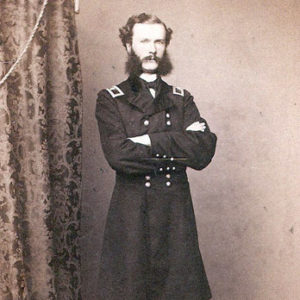calsfoundation@cals.org
Francis Jay Herron (1837–1902)
Francis Jay Herron, a Union general, saw extensive service in Arkansas and Missouri during the early years of the Civil War. He later held various political posts in Reconstruction Louisiana before moving to New York City in 1877. He was one of four soldiers awarded the Medal of Honor for gallantry at the Battle of Pea Ridge in Arkansas.
Francis Herron, the third child of John and Clarissa Herron, was born in Pittsburgh, Pennsylvania, on February 17, 1837. He enrolled in Western University but left in 1855 to join his three brothers who had established a bank in Dubuque, Iowa. Four years later, Herron created and became captain of a local militia unit, the Governor’s Grays. On May 14, 1861, Herron’s unit joined the army as Company I, First Iowa Infantry. The ninety-day unit was roughly handled at the Battle of Wilson’s Creek, Missouri, on August 10, 1861, suffering 154 casualties. On August 20, 1861, the regiment mustered out of service, and Herron became lieutenant colonel of the Ninth Iowa Infantry on September 24, 1861.
Herron commanded the regiment on March 7, 1862, at the Battle of Pea Ridge. That evening, when the Federal position at Elkhorn Tavern was about to be outflanked, Herron repeatedly rallied his men to help stop the advance. Near the end of the fighting, Herron’s horse was shot from under him, and he was captured. His regiment suffered 218 casualties, which was the highest number of any Union unit in the battle. Herron was exchanged on March 20, 1862, and on July 16, 1862, he was promoted to brigadier general. Thirty-one years after the battle, the U.S. Congress, on September 26, 1893, awarded Herron the Medal of Honor for his heroism at Pea Ridge.
On October 12, 1862, Herron assumed command of the Third Division of the Army of the Frontier. In early December, his division was near the old Wilson Creek battlefield when he received word that Brigadier General James G. Blunt’s division near Cane Hill (Washington County) would soon be facing seemingly overwhelming Confederate forces. Blunt needed help, and Herron responded immediately. On December 3, Herron’s division, and the Second Division that also was under his command, began moving southward. The two divisions contained about 4,000 infantry and 2,000 cavalry. During the next three and a half days, elements of Herron’s command marched almost 120 miles over bad roads and often in bitterly cold weather. It was one of the longest extended marches in the Civil War, and it saved Blunt from almost certain defeat.
On the morning of December 7, 1862, Herron began deploying his weary infantry near Prairie Grove (Washington County). He faced the bulk of the Rebel army, which had turned its attention from Blunt to Herron. Herron, though hard pressed and in danger of being defeated, managed to hold his ground until Blunt marched to his assistance that afternoon.
The fighting, which lasted about ten hours, made this one of the bloodiest days in the Trans-Mississippi West. The Confederates broke off the action after suffering almost 1,500 casualties out of a total force of 10,000. Union losses during the Battle of Prairie Grove were 1,250 out of about 8,000 engaged.
Herron was appointed major general on March 10, 1863, and subsequently commanded a division in the siege of Vicksburg, Mississippi. After the city surrendered, he served in Louisiana and Texas until the war ended.
Herron left the army on June 7, 1865. He settled in Louisiana, where he practiced law and became active in Reconstruction politics. He served as tax collector in New Orleans, U.S. marshal (1867–1869), and acting secretary of state (1871–1872). When Reconstruction ended and Republican power across the South waned, Herron moved to New York City in 1877. There, he practiced law and may have briefly engaged in banking and manufacturing. However, he succeeded at nothing and died a pauper in a tenement on West 99th Street on January 8, 1902.
For additional information:
Banasik, Michael E. Embattled Arkansas: The Prairie Grove Campaign of 1862. Wilmington, NC: Broadfoot, 1996.
Shea, William L. Fields of Blood: The Prairie Grove Campaign. Chapel Hill: University of North Carolina Press, 2009.
Warner, Ezra. Generals in Blue. Baton Rouge: Louisiana State University Press, 1981.
Bobby Roberts
Central Arkansas Library System
 Military
Military Blunt-Herron Monument
Blunt-Herron Monument  Francis Herron
Francis Herron  Francis Herron
Francis Herron 




Comments
No comments on this entry yet.